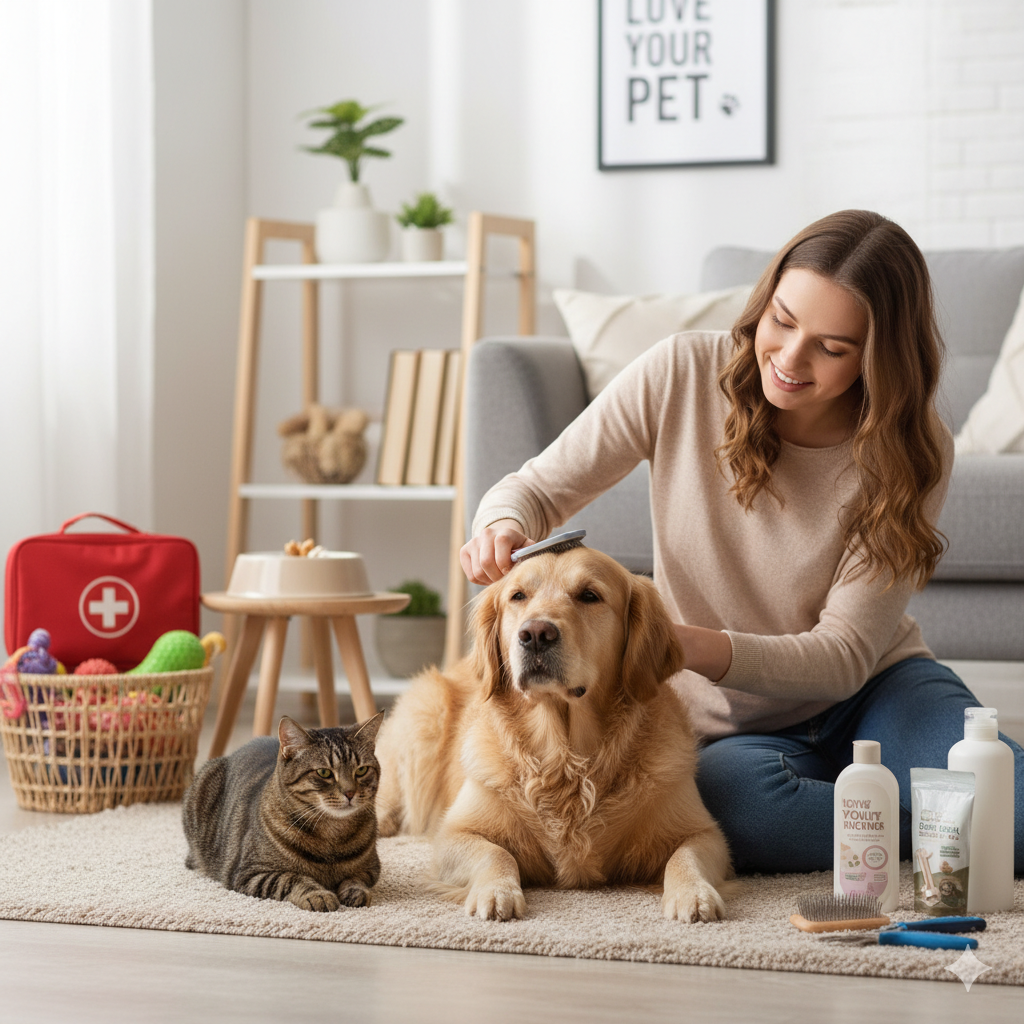
Top Pet Care Tips Every Owner Must Know to Keep Their Pets Healthy & Safe

Whether you have a dog, cat, rabbit, or exotic pet, proper care is essential for longevity and happiness. Below are the **top 20 pet care tips** that combine expert veterinary guidance, real owner experience. Use them as your foundational guide and update with local/regional details where needed.
1. Balanced Nutrition & Diet
Provide species-appropriate and life-stage-appropriate food. Choose high-quality commercial food (or raw/home-prepared if supervised by a vet). Ensure the food meets AAFCO (US) or FEDIAF (EU) standards.
2. Always Provide Fresh Water
Hydration is critical. Always have clean, fresh water available. Consider using water fountains or multiple bowls for multi-pet households. In warm climates or for active pets, add extra bowls outdoors. (e.g. Automatic Pet feeder)
3. Regular Veterinary Checkups & Vaccinations
Annual or biannual vet visits help catch problems early. Maintain a vaccination schedule (core + region-specific non-core). Get your vet’s recommendation for fleas, ticks, heartworm, etc.
4. Parasite Prevention (Fleas, Ticks, Worms)
Use vet-recommended preventives (topical, oral, collars) to guard against fleas, ticks, heartworm, intestinal parasites. Tailor frequency based on your region’s climate and parasite risk.
5. Dental & Oral Hygiene
Brush your pet’s teeth daily or at least several times a week using pet-safe toothpaste. Provide dental chews or toys or dental diets to reduce plaque.
6. Daily Exercise & Mental Enrichment
Appropriate exercise by species, age, and health is essential—walks, play, fetch, cat climbing towers, puzzle feeders, etc. Lack of mental stimulation can lead to behavioral issues.
7. Reduce Stress & Provide a Safe, Stable Environment
Pets thrive on routines. Feed, walk, and rest at consistent times. Provide safe hiding spots or dens. Avoid loud noises or overcrowded spaces.
8. Grooming, Skin & Coat Care
Brush regularly, bathe when needed with pet-safe shampoo, trim nails properly, clean ears/eyes. Monitor for lumps, bumps, ticks.
9. Home Safety & Pet-Proofing
Remove toxic plants, secure wires and cords, keep human medicines / chemicals locked, avoid small ingestible hazards. Use gates to restrict dangerous zones (e.g. stairs, kitchen).
10. Safe Travel & Transportation
Use a crash-tested carrier or harness in vehicles. Never let pets ride loose in cars. For air or rail travel, verify carrier compliance and acclimate pets slowly.
11. Basic Training, Socialization & Behavior
Train core commands (sit, stay, come). Socialize early with other pets, people, and environments. Use positive reinforcement, not punishment.
12. Monitor Health & Behavior Changes
Watch for appetite changes, lethargy, vomiting, stool changes, limping, behavior shifts. Early detection is key. Keep a health log or app.
13. Emergency Preparedness
Have a pet-first aid kit, vet emergency contacts, and know the closest 24h clinic. Learn basic CPR and choking rescue for pets.
14. Senior & Geriatric Pet Care
Older pets may need gentle diets, joint supplements, more frequent veterinary checks, softer bedding, and temperature control.
15. Special Diets, Food Allergies & Sensitivities
Some pets require grain-free, hypoallergenic, or prescription diets. Always consult a vet before switching. Monitor for skin irritation, GI upset, or ear infections which may signal allergies.
16. Identification & Microchipping
Use collar with ID tag (name + your phone). Microchip your pet and register it with local registry. Update info if you move.
17. Environment Cleanliness & Hygiene
Clean litter boxes, cages, bedding, and litter pans frequently. Wash pet laundry separately. Sanitize toys, food/water dishes, and grooming tools.
18. Enrichment, Toys & Safe Chewing
Provide safe chew toys, puzzles, scratching posts, and climbing structures. Use them to reduce boredom and destructive behaviors.
19. Weight Management & Monitoring
Obesity is a top risk factor for many diseases. Monitor body condition, measure food portions, and adjust based on age/activity. Use monthly weigh-ins.
20. Continuous Owner Education & Trusted Resources
Be an informed pet owner. Subscribe to trusted veterinary blogs, join pet-owner communities, and stay current with research and guidelines.
Conclusion
Proper pet care is a lifelong commitment. These 20 tips cover the most critical areas—nutrition, preventive care, safety, enrichment, and more. Use this post as your master checklist, revisit it regularly, and tailor it to your pet’s breed, age, and individual needs.
If you’re interested in recommended products (food, toys, health supplies) or need personalized advice, feel free to contact us. And share this guide with fellow pet owners to help spread healthier, happier pet care.
Frequently Asked Questions (FAQs)
At least once a year for a routine checkup and vaccinations. Senior pets or those with medical issues may need biannual visits.
A balanced diet made of high-quality commercial pet food that meets AAFCO or FEDIAF standards. Always adjust for age, breed, and activity level.
Keep your home clean, vacuum often, and groom your pet regularly. You can also use vet-approved natural sprays or collars for added protection.
You should be able to feel (but not see) your pet’s ribs and see a visible waist. Consult your vet for a proper body condition score.
Use a vet-recommended ear cleaner. Apply a few drops, gently massage the ear base, and wipe with cotton or gauze—never insert cotton swabs.
No. Always use pH-balanced pet shampoo to protect their skin barrier and prevent irritation.
Provide a consistent routine, safe space, regular exercise, and enrichment. Pheromone diffusers or vet-recommended calming aids can also help.
Try warming the food or offering a bland diet like boiled chicken and rice. If it lasts more than 24 hours, see a vet immediately.
Only a few human foods (like plain pumpkin, carrots, or cooked chicken) are safe. Avoid chocolate, onions, grapes, xylitol, and caffeine.
Remove toxic plants, secure wires, store cleaning products out of reach, and use safety gates to block hazardous areas.




